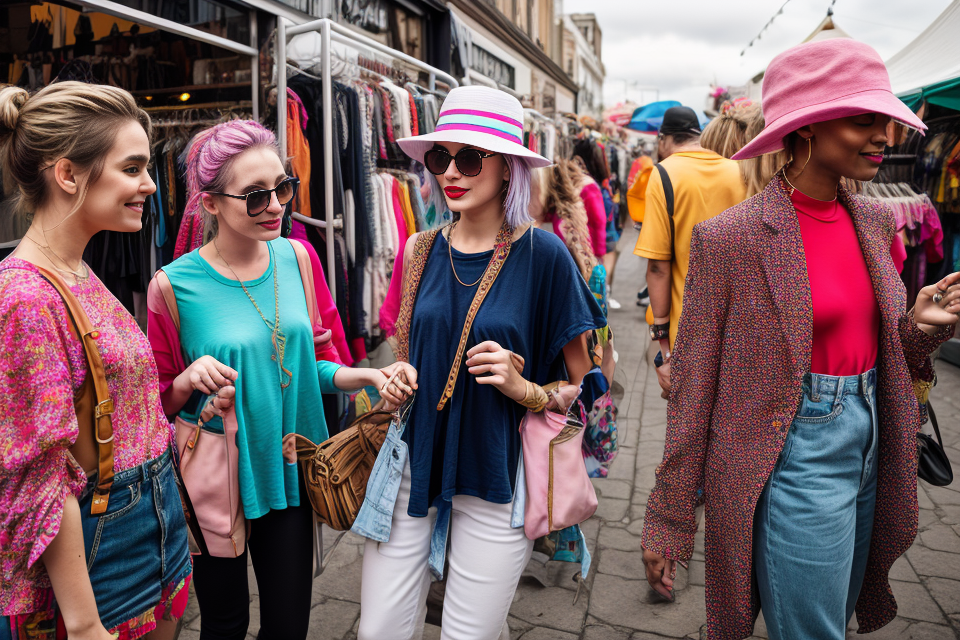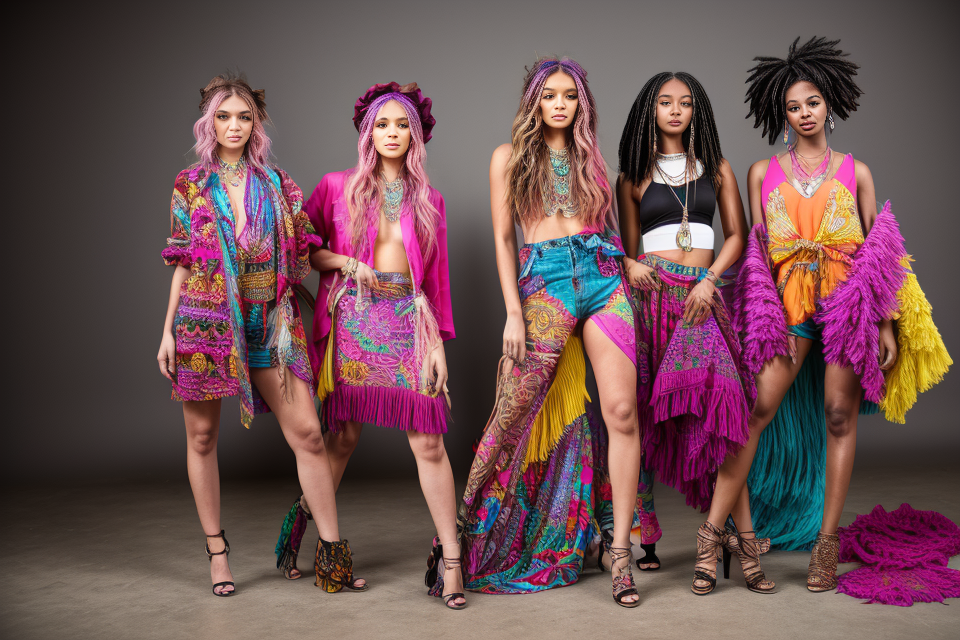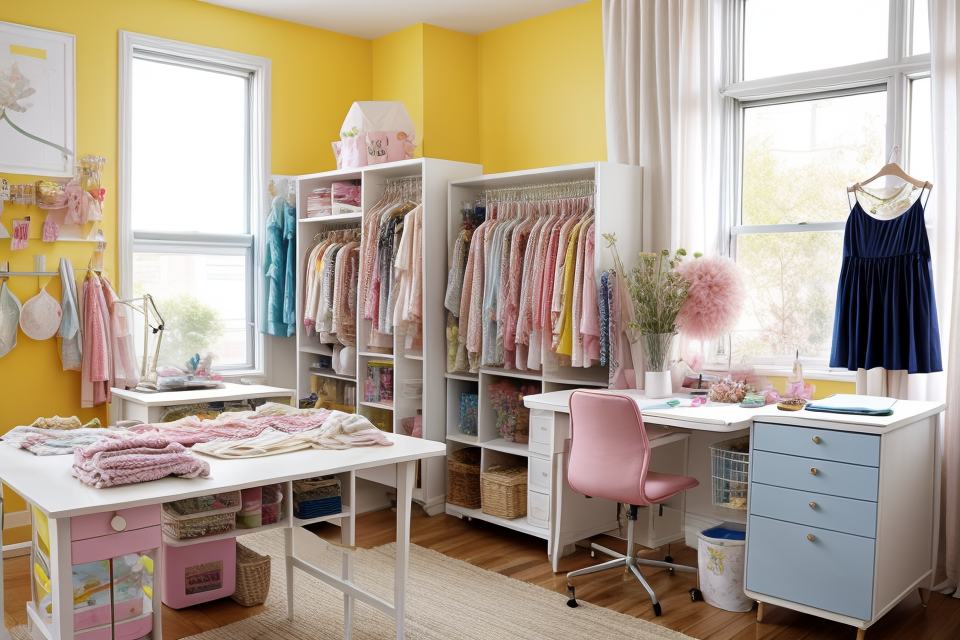
DIY Designer, also known as Do-It-Yourself Designer, is a term used to describe individuals who create their own fashion designs, often using affordable and accessible resources. With the rise of digital technology and social media platforms, it has become easier than ever for independent fashion creators to showcase their work and connect with audiences. This trend has given birth to a new generation of fashion designers who are challenging traditional industry norms and redefining what it means to be a fashion professional. In this article, we will explore the world of DIY Designers and the impact they are having on the fashion industry.
The Emergence of DIY Designers
The Growth of Online Platforms
E-commerce Sites
In recent years, e-commerce sites have become a prominent platform for independent fashion creators to showcase and sell their designs. Websites such as Etsy, Shopify, and Big Cartel provide easy-to-use templates and tools that allow designers to create their own online stores with minimal technical knowledge. These platforms also offer various payment options, shipping options, and customer service support, which make it easier for independent designers to reach a wider audience.
Social Media Platforms
Social media platforms, such as Instagram and TikTok, have played a significant role in the rise of independent fashion creators. These platforms allow designers to share their work with a global audience, gain followers, and connect with potential customers. Instagram, in particular, has become a hub for independent fashion designers, with many using the platform to showcase their designs, engage with followers, and promote their brand. Additionally, social media influencers have also played a role in promoting independent fashion designers, giving them a platform to reach a wider audience.
Furthermore, social media platforms have also made it easier for independent designers to market their products and interact with customers. For example, Instagram allows designers to tag their products, enabling customers to easily purchase items from their profiles. This has made it easier for independent designers to reach a wider audience and compete with larger fashion brands.
The Desire for Unique Fashion
Personal Style
The desire for unique fashion has led to the emergence of DIY designers. With the rise of social media platforms, individuals have the power to showcase their personal style and gain recognition for their creativity. The demand for individuality in fashion has given birth to a new generation of independent designers who create clothing and accessories that reflect their unique sense of style. These creators are not limited by traditional fashion rules and are free to experiment with different fabrics, colors, and silhouettes. As a result, the fashion industry has become more diverse, with a wider range of styles and aesthetics available to consumers.
Sustainability and Ethical Production
Another factor contributing to the rise of DIY designers is the growing awareness of sustainability and ethical production in the fashion industry. Many consumers are now more conscious of the environmental impact of fast fashion and are seeking out more sustainable and ethical alternatives. DIY designers offer a solution to this problem by creating clothing and accessories using sustainable materials and ethical production methods. They often use recycled or upcycled materials, which reduces waste and carbon emissions. Additionally, DIY designers can ensure that their products are made under fair labor conditions, providing consumers with a more transparent and ethical fashion choice.
The Skills and Tools of DIY Designers
Design and Pattern Making
Design and pattern making are essential skills for any DIY fashion creator. They are the foundation upon which the entire creative process is built. In this section, we will delve into the basic and advanced techniques that independent fashion creators use to bring their designs to life.
Basic Skills
At the core of design and pattern making are the basic skills that every DIY fashion creator should master. These skills include:
- Understanding body measurements and proportions
- Drawing basic shapes and silhouettes
- Creating a simple pattern from a basic block
- Cutting and sewing basic garments
These basic skills form the building blocks of fashion design and pattern making. They are essential for creating a well-fitting garment and understanding the fundamentals of design.
Advanced Techniques
Once the basic skills have been mastered, DIY fashion creators can move on to more advanced techniques. These techniques include:
- Draping and muslining
- Creating custom patterns from existing garments
- Developing a collection or range
- Using specialized tools and equipment
These advanced techniques allow independent fashion creators to push the boundaries of their designs and create unique, high-quality garments. They also enable creators to develop their own signature style and stand out in a crowded market.
In addition to these techniques, independent fashion creators also have access to a wide range of tools and resources that can help them in their design process. These tools include:
- Pattern-making software
- Fabric cutting and measurement tools
- Sewing machines and equipment
- Online resources and communities
These tools and resources provide independent fashion creators with the support they need to bring their designs to life and grow their businesses. With the right skills and tools, anyone can become a DIY fashion creator and make their mark in the industry.
Fabric Selection and Sourcing
Quality and Sustainability
As independent fashion creators, one of the most important factors in fabric selection is the quality of the material. High-quality fabrics not only look and feel better, but they also last longer and can withstand repeated wear and washing. In addition, many DIY designers are also increasingly focused on sustainability, and they prioritize fabrics that are made from eco-friendly materials or that can be easily recycled.
Budget and Availability
Another key factor in fabric selection is budget and availability. Many independent fashion creators work with limited resources, and they need to carefully consider the cost of materials when creating their designs. In addition, availability can also be a factor, as some fabrics may be difficult to find or may only be available in certain locations. As a result, many DIY designers are turning to online retailers and marketplaces to source their materials, which can offer a wider range of options and more competitive pricing.
Style and Functionality
Finally, the style and functionality of the fabric is also an important consideration for many DIY designers. Different fabrics have different properties and can be better suited for certain types of garments or designs. For example, a heavy cotton fabric may be better for creating denim jeans, while a lightweight silk fabric may be better for a flowing dress. In addition, the texture and pattern of the fabric can also affect the overall look and feel of the finished garment. As a result, many DIY designers take the time to carefully consider the style and functionality of the fabric when making their selections.
Marketing and Promotion
In today’s fashion industry, independent fashion creators need to be skilled in marketing and promotion to gain visibility and reach their target audience. Here are some of the strategies that DIY designers can use to promote their work:
Social Media Strategies
Social media platforms like Instagram, Facebook, and Twitter have become powerful tools for independent fashion creators to showcase their work and connect with their audience. DIY designers can use social media to share their designs, behind-the-scenes footage, and personal stories to create a unique brand identity and engage with their followers. They can also use hashtags to increase their visibility and reach a wider audience.
Collaborations and Partnerships
Collaborations and partnerships with other independent fashion creators, influencers, and brands can help DIY designers expand their reach and gain exposure. They can collaborate on collections, events, and campaigns to reach new audiences and gain valuable feedback and exposure. Collaborations can also help independent fashion creators build relationships and network with other industry professionals.
By utilizing these marketing and promotion strategies, independent fashion creators can build a strong brand identity, connect with their audience, and gain exposure in the competitive fashion industry.
The Challenges of Being a DIY Designer
Balancing Creativity and Business
As a DIY fashion designer, balancing creativity and business can be a challenging task. It requires a delicate balance between the artistic side of designing and the practical aspects of running a business.
Time Management
One of the biggest challenges for DIY designers is managing their time effectively. As a solo entrepreneur, you have to handle all aspects of your business, from designing and creating your products to marketing and selling them. This can be a daunting task, especially when you have to balance it with other commitments such as a day job or family responsibilities.
To manage your time effectively, it’s important to set priorities and create a schedule that works for you. You can start by identifying the most important tasks that need to be done and allocating specific time slots for them. It’s also important to set realistic goals and deadlines for yourself, and to be flexible enough to adjust them if necessary.
Financial Management
Another challenge that DIY designers face is financial management. As a solo entrepreneur, you are responsible for all aspects of your business, including finances. This means that you have to manage your cash flow, keep track of your expenses, and make strategic financial decisions.
To manage your finances effectively, it’s important to keep accurate records of your income and expenses. You can use accounting software or apps to help you track your expenses and create invoices. It’s also important to have a clear understanding of your business costs, such as materials, manufacturing, and marketing expenses.
In addition to managing your finances, you also have to make strategic decisions about pricing and sales. As a DIY designer, you have the flexibility to set your own prices, but it’s important to balance your creativity with business realities. You have to consider factors such as production costs, market demand, and competition when setting your prices.
In conclusion, balancing creativity and business is a critical challenge for DIY designers. It requires effective time management, financial management, and strategic decision-making. By managing your time and finances effectively, and making strategic decisions about pricing and sales, you can achieve a delicate balance between your artistic side and the practical aspects of running a business.
Competition and Standing Out
As the world of fashion becomes increasingly saturated with independent designers, it’s becoming more and more difficult for new creators to make a name for themselves. Market saturation means that there are simply too many designers vying for the same customers, making it difficult to stand out and make a profit.
Market Saturation
One of the biggest challenges facing DIY designers is the sheer number of other creators in the market. With so many designers producing unique and creative pieces, it can be difficult to differentiate oneself and make a lasting impression. This is especially true in a world where fast fashion has become increasingly prevalent, making it even harder for independent designers to compete.
Differentiating from Fast Fashion
Another challenge facing DIY designers is the rise of fast fashion. Fast fashion brands are able to produce large quantities of clothing at a lower cost than independent designers, making it difficult for smaller brands to compete. To differentiate themselves from fast fashion, independent designers must focus on creating unique and high-quality pieces that cannot be found anywhere else.
Additionally, independent designers must also focus on building a strong brand identity. This means creating a unique image and voice that sets them apart from other designers and resonates with their target audience. This can be achieved through a variety of methods, such as social media marketing, influencer partnerships, and pop-up shops.
Despite these challenges, many DIY designers are finding success by focusing on creating high-quality, unique pieces and building a strong brand identity. By doing so, they are able to stand out in a crowded market and build a loyal customer base.
The Future of DIY Designers
Continued Growth and Evolution
The future of DIY designers looks promising, with continued growth and evolution expected in the industry. This growth can be attributed to several factors, including technology and innovation, as well as changes in consumer demand and preferences.
Technology and Innovation
One of the key drivers of growth for DIY designers is technology and innovation. Advances in technology have made it easier for independent fashion creators to produce high-quality designs and reach a wider audience. For example, the rise of social media platforms has given DIY designers a platform to showcase their work and connect with potential customers. Additionally, technology has enabled the development of new tools and resources that help designers streamline their workflow and improve the quality of their designs.
Consumer Demand and Preferences
Another factor contributing to the growth of the DIY fashion industry is changing consumer demand and preferences. In recent years, there has been a growing trend towards personalization and individuality in fashion. Consumers are increasingly looking for unique, one-of-a-kind pieces that reflect their personal style and values. This has created a demand for independent fashion creators who can offer custom-made designs and unique styles that are not available in traditional retail stores.
Furthermore, the rise of sustainable fashion has also fueled the growth of the DIY fashion industry. Consumers are becoming more conscious of the environmental impact of their purchases and are looking for more sustainable alternatives. DIY designers who use eco-friendly materials and practices are well-positioned to meet this demand and appeal to environmentally-conscious consumers.
Overall, the future of DIY designers looks bright, with continued growth and evolution expected in the industry. As technology and innovation continue to advance, and consumer demand for personalization and sustainability grows, the role of independent fashion creators is likely to become increasingly important in the fashion industry.
The Impact on the Fashion Industry
Disruption of Traditional Business Models
The rise of DIY designers has had a significant impact on the fashion industry. One of the most notable effects has been the disruption of traditional business models.
Traditionally, the fashion industry has been dominated by a small number of large brands and retailers. These companies have relied on a hierarchical structure, with designs and products being created by in-house teams and then sold through physical stores or online platforms. However, the emergence of independent fashion creators has disrupted this model, allowing for a more democratic and decentralized approach to fashion design and production.
Opportunities for Collaboration and Innovation
The rise of DIY designers has also created new opportunities for collaboration and innovation within the fashion industry. Independent designers are often more willing to take risks and experiment with new ideas, which can lead to exciting and innovative designs. In addition, the use of social media platforms such as Instagram and TikTok has made it easier for independent designers to showcase their work and connect with potential collaborators.
This has led to an increase in collaborations between independent designers and established brands, as well as the creation of new partnerships and ventures. For example, some independent designers have teamed up with retailers to create exclusive collections, while others have launched their own labels and gained recognition within the industry.
Overall, the rise of DIY designers has had a significant impact on the fashion industry, disrupting traditional business models and creating new opportunities for collaboration and innovation. As the trend continues to grow, it will be interesting to see how the industry adapts and evolves in response.
FAQs
1. What is a DIY designer?
A DIY designer is an independent fashion creator who designs and produces their own clothing and accessories. They may use a variety of techniques, such as sewing, knitting, or embroidery, to create unique pieces. DIY designers often use affordable materials and upcycled clothing to create sustainable and affordable fashion.
2. What inspired the rise of DIY designers?
The rise of DIY designers can be attributed to several factors, including the increasing interest in sustainable fashion, the accessibility of technology and social media, and the desire for unique and personalized clothing. DIY designers are also able to express their creativity and build their own brand without the need for traditional fashion industry resources.
3. How do DIY designers market their products?
DIY designers use a variety of methods to market their products, including social media platforms like Instagram and TikTok, online marketplaces like Etsy, and pop-up shops and fashion events. They often leverage their own personal brand and social media following to promote their designs and reach a wider audience.
4. What are the benefits of being a DIY designer?
The benefits of being a DIY designer include the ability to create unique and personalized clothing, the freedom to work on their own schedule and terms, and the potential to build a successful business and brand. DIY designers also have the opportunity to make a positive impact on the environment by using sustainable materials and practices.
5. What challenges do DIY designers face?
DIY designers face a number of challenges, including finding affordable materials and production space, navigating legal and business requirements, and building a customer base. They may also struggle to stand out in a crowded market and maintain a consistent brand image.
6. How can I become a DIY designer?
To become a DIY designer, you will need to develop your design skills and knowledge of fashion and textiles. You can do this by taking classes, studying fashion design, and experimenting with different techniques and materials. You will also need to build a brand and marketing strategy, and decide on a business model and pricing structure. Finally, you will need to find a way to produce and distribute your designs, whether through online marketplaces or your own website and pop-up shops.


